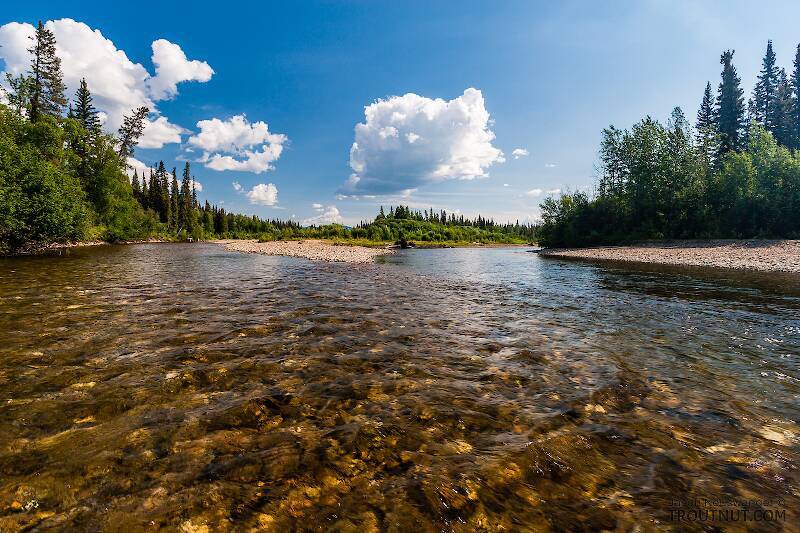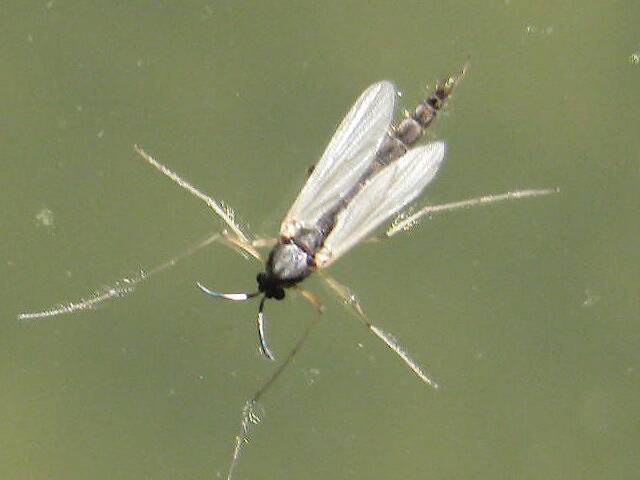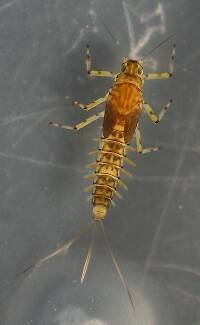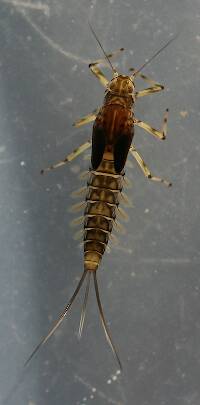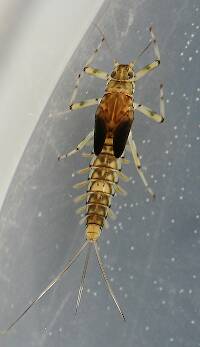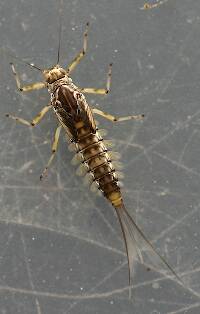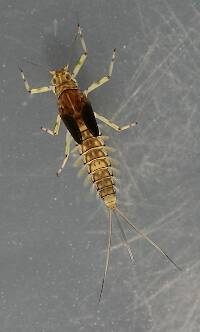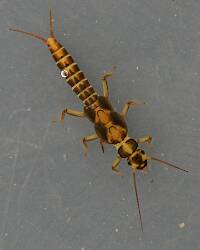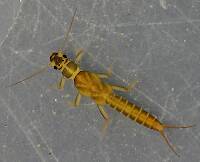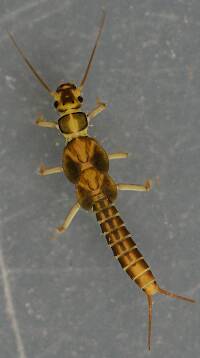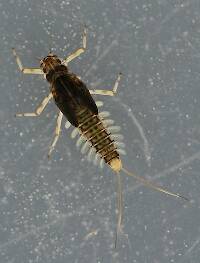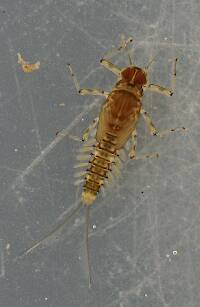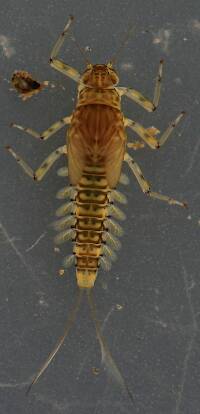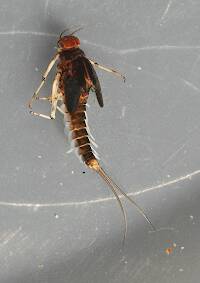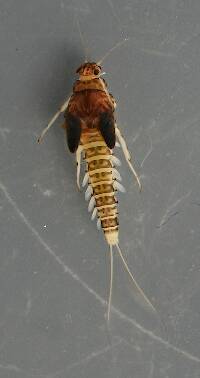
Hex Mayflies
Hexagenia limbata
The famous nocturnal Hex hatch of the Midwest (and a few other lucky locations) stirs to the surface mythically large brown trout that only touch streamers for the rest of the year.
Featured on the forum

This one was surprisingly straightforward to identify. The lack of a sclerite at the base of the lateral hump narrows the field quite a bit, and the other options followed fairly obvious characteristics to Clostoeca, which only has one species, Clostoeca disjuncta.

Troutnut is a project started in 2003 by salmonid ecologist Jason "Troutnut" Neuswanger to help anglers and
fly tyers unabashedly embrace the entomological side of the sport. Learn more about Troutnut or
support the project for an enhanced experience here.
Feathers5
Posts: 287
Posts: 287
Feathers5 on Aug 28, 2014August 28th, 2014, 4:55 am EDT
http://www.troutnut.com/specimen/694
Question: If the nymphs go down in size to 22, 24 or 26, why does everyone recommend tyng size 18 or 20 nymphs?
Bruce
Question: If the nymphs go down in size to 22, 24 or 26, why does everyone recommend tyng size 18 or 20 nymphs?
Bruce
Falsifly on Aug 29, 2014August 29th, 2014, 11:46 am EDT
Question: If the nymphs go down in size to 22, 24 or 26, why does everyone recommend tyng size 18 or 20 nymphs?
Bruce, first of all who is everyone? Second, very few if anything in this so-called "sport" is set in stone no?
Falsifly
When asked what I just caught that monster on I showed him. He put on his magnifiers and said, "I can't believe they can see that."
When asked what I just caught that monster on I showed him. He put on his magnifiers and said, "I can't believe they can see that."
Entoman on Aug 30, 2014August 30th, 2014, 2:58 pm EDT
Bruce,
Generally, it's a good idea to match the size of the naturals. The problem with nymphs below size 20 is that hooking becomes problematic. Proper setting of tiny hooks requires exquisite timing and touch - very hard to do fishing an unseen nymph... Unless I'm sight fishing (can see the take), I tend to stay away from the real tiny stuff. If I can... ;)
Generally, it's a good idea to match the size of the naturals. The problem with nymphs below size 20 is that hooking becomes problematic. Proper setting of tiny hooks requires exquisite timing and touch - very hard to do fishing an unseen nymph... Unless I'm sight fishing (can see the take), I tend to stay away from the real tiny stuff. If I can... ;)
"It's not that I find fishing so important, it's just that I find all other endeavors of Man equally unimportant... And not nearly as much fun!" Robert Traver, Anatomy of a Fisherman
Martinlf on Aug 30, 2014August 30th, 2014, 5:38 pm EDT
TIEMCO 2488.
"He spread them a yard and a half. 'And every one that got away is this big.'"
--Fred Chappell
--Fred Chappell
PaulRoberts on Aug 31, 2014August 31st, 2014, 5:52 pm EDT
Ah! Bruce is asking the same question I just did in his other thread.
Oldredbarn on Aug 31, 2014August 31st, 2014, 8:25 pm EDT
Question: If the nymphs go down in size to 22, 24 or 26, why does everyone recommend tyng size 18 or 20 nymphs?
Bruce
Bruce,
Aren't you reading my answers to you in your other threads on this topic?!
The answer, one more time...There are more than one species of nymphs out there at the same time. They are different bugs. It isn't the same species at all these different sizes.
The traditional "Fall Baetis" is an 16/18 in our waters...From a Baetis standpoint it is the largest Baetis we have...But, there also can be other "olives" out there.
Tie your favorite pattern of PT Nymphs in all sizes and just pay attention.
Spence
"Even when my best efforts fail it's a satisfying challenge, and that, after all, is the essence of fly fishing." -Chauncy Lively
"Envy not the man who lives beside the river, but the man the river flows through." Joseph T Heywood
"Envy not the man who lives beside the river, but the man the river flows through." Joseph T Heywood
PaulRoberts on Aug 31, 2014August 31st, 2014, 8:42 pm EDT
Bruce,
Generally, it's a good idea to match the size of the naturals. The problem with nymphs below size 20 is that hooking becomes problematic. Proper setting of tiny hooks requires exquisite timing and touch - very hard to do fishing an unseen nymph... Unless I'm sight fishing (can see the take), I tend to stay away from the real tiny stuff. If I can... ;)
If I understnad the OP (other thread -why there are three of them I'm not sure.) the question was does anyone fish deep with #24/26 nymphs? I know I don't. I'll go with Kurt's answer and be done with it.
Planettrout on Aug 31, 2014August 31st, 2014, 8:44 pm EDT
..or:
"Baetis and related nymphs range from size 14 down to 24. The most common are 16 to 20"
Western Mayfly Hatches-From the Rockies to the Pacific - Rick Hafele, Dave Hughes Pg. 43, 3rd. paragraph...
Like it was suggested by Martinlf above: TMC 2488 hooks and I would add to that Tiemco 16/0 Thread and Semperfli 18/0 Nano Silk soon become one's best new friends...for tying small Baetis nymphs...like these:
http://www.charliesflyboxinc.com/flybox/print.cfm?parentID=70
PT/TB :o)
"Baetis and related nymphs range from size 14 down to 24. The most common are 16 to 20"
Western Mayfly Hatches-From the Rockies to the Pacific - Rick Hafele, Dave Hughes Pg. 43, 3rd. paragraph...
Like it was suggested by Martinlf above: TMC 2488 hooks and I would add to that Tiemco 16/0 Thread and Semperfli 18/0 Nano Silk soon become one's best new friends...for tying small Baetis nymphs...like these:
http://www.charliesflyboxinc.com/flybox/print.cfm?parentID=70
PT/TB :o)
Daughter to Father: "How many arms do you have, how many fly rods do you need?"
http://planettrout.wordpress.com/
http://planettrout.wordpress.com/
PaulRoberts on Aug 31, 2014August 31st, 2014, 8:47 pm EDT
Ah...I re-read the OP. I was thinking Bruce was talking about the really tiny late summer into fall guys -the season you all are in now. Guess I read in to what Bruce was asking.
Feathers5
Posts: 287
Posts: 287
Feathers5 on Sep 3, 2014September 3rd, 2014, 5:26 am EDT
I am talking about the tiny late summer flies.
PaulRoberts on Sep 3, 2014September 3rd, 2014, 4:59 pm EDT
I thought so. See my very first post in one of these threads. I blab on about "micro-nymphing" in a more general sort of way, since I don't specifically target #24/26 Baetids. I know I have a few #22 shot shank "Baetid" nymphs in a box that might as well be, and I'd use interchangeably with, some midge pupae I've seen.
Quick Reply
Related Discussions
Topic
Replies
Last Reply
6
Feb 21, 2009
by Martinlf
by Martinlf
7
Sep 18, 2006
by Troutnut
by Troutnut

